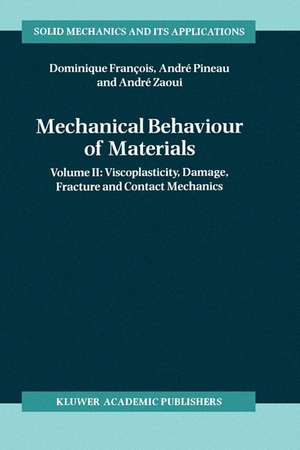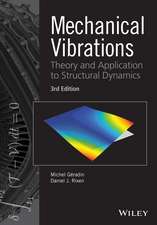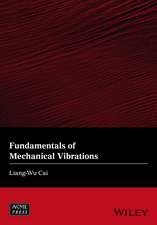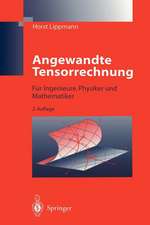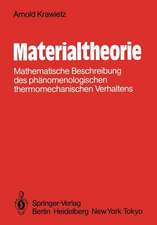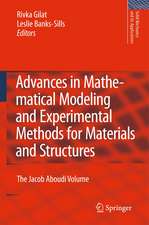Mechanical Behaviour of Materials: Volume II: Viscoplasticity, Damage, Fracture and Contact Mechanics: Solid Mechanics and Its Applications, cartea 58
Autor Dominique François, André Pineau, André Zaouien Limba Engleză Hardback – 30 noi 1998
| Toate formatele și edițiile | Preț | Express |
|---|---|---|
| Paperback (3) | 646.62 lei 6-8 săpt. | |
| SPRINGER NETHERLANDS – 6 dec 2010 | 646.62 lei 6-8 săpt. | |
| SPRINGER NETHERLANDS – 29 ian 2015 | 963.29 lei 6-8 săpt. | |
| SPRINGER NETHERLANDS – 16 apr 2014 | 1397.19 lei 6-8 săpt. | |
| Hardback (3) | 653.00 lei 6-8 săpt. | |
| SPRINGER NETHERLANDS – 30 noi 1998 | 653.00 lei 6-8 săpt. | |
| SPRINGER NETHERLANDS – 23 dec 2012 | 980.47 lei 6-8 săpt. | |
| SPRINGER NETHERLANDS – 14 mar 2012 | 1401.93 lei 6-8 săpt. |
Din seria Solid Mechanics and Its Applications
- 20%
 Preț: 698.10 lei
Preț: 698.10 lei - 24%
 Preț: 800.16 lei
Preț: 800.16 lei -
 Preț: 402.14 lei
Preț: 402.14 lei - 15%
 Preț: 640.06 lei
Preț: 640.06 lei - 15%
 Preț: 653.14 lei
Preț: 653.14 lei - 18%
 Preț: 1124.92 lei
Preț: 1124.92 lei - 15%
 Preț: 643.84 lei
Preț: 643.84 lei - 18%
 Preț: 1119.38 lei
Preț: 1119.38 lei - 20%
 Preț: 573.20 lei
Preț: 573.20 lei - 18%
 Preț: 1607.92 lei
Preț: 1607.92 lei - 17%
 Preț: 393.72 lei
Preț: 393.72 lei - 17%
 Preț: 459.41 lei
Preț: 459.41 lei - 18%
 Preț: 959.98 lei
Preț: 959.98 lei - 18%
 Preț: 747.71 lei
Preț: 747.71 lei -
 Preț: 388.55 lei
Preț: 388.55 lei - 18%
 Preț: 787.15 lei
Preț: 787.15 lei -
 Preț: 406.25 lei
Preț: 406.25 lei - 15%
 Preț: 639.08 lei
Preț: 639.08 lei - 24%
 Preț: 784.84 lei
Preț: 784.84 lei - 15%
 Preț: 643.34 lei
Preț: 643.34 lei - 18%
 Preț: 958.07 lei
Preț: 958.07 lei - 18%
 Preț: 1228.15 lei
Preț: 1228.15 lei - 18%
 Preț: 734.27 lei
Preț: 734.27 lei - 18%
 Preț: 1233.06 lei
Preț: 1233.06 lei - 18%
 Preț: 1236.19 lei
Preț: 1236.19 lei - 18%
 Preț: 950.96 lei
Preț: 950.96 lei - 18%
 Preț: 906.48 lei
Preț: 906.48 lei - 18%
 Preț: 964.54 lei
Preț: 964.54 lei - 20%
 Preț: 995.75 lei
Preț: 995.75 lei - 18%
 Preț: 953.65 lei
Preț: 953.65 lei - 18%
 Preț: 1239.67 lei
Preț: 1239.67 lei - 18%
 Preț: 962.35 lei
Preț: 962.35 lei - 18%
 Preț: 964.54 lei
Preț: 964.54 lei - 18%
 Preț: 913.11 lei
Preț: 913.11 lei - 18%
 Preț: 1226.90 lei
Preț: 1226.90 lei
Preț: 653.00 lei
Preț vechi: 768.23 lei
-15% Nou
Puncte Express: 980
Preț estimativ în valută:
124.96€ • 133.62$ • 104.18£
124.96€ • 133.62$ • 104.18£
Carte tipărită la comandă
Livrare economică 18 aprilie-02 mai
Preluare comenzi: 021 569.72.76
Specificații
ISBN-13: 9780792348955
ISBN-10: 0792348958
Pagini: 410
Ilustrații: XI, 410 p.
Dimensiuni: 156 x 234 x 24 mm
Greutate: 0.77 kg
Ediția:1998
Editura: SPRINGER NETHERLANDS
Colecția Springer
Seria Solid Mechanics and Its Applications
Locul publicării:Dordrecht, Netherlands
ISBN-10: 0792348958
Pagini: 410
Ilustrații: XI, 410 p.
Dimensiuni: 156 x 234 x 24 mm
Greutate: 0.77 kg
Ediția:1998
Editura: SPRINGER NETHERLANDS
Colecția Springer
Seria Solid Mechanics and Its Applications
Locul publicării:Dordrecht, Netherlands
Public țintă
ResearchCuprins
Foreword.- 1. Various types of damage.- 2. Fracture mechanics.- 3. Brittle fracture.- 4. Ductile fracture.- 5. Ductile-brittle transition.- 6. Fatigue.- 7. Environment assited cracking.- 8. Creep-fatigue-oxidation interactions.- 9. Contact mechanics - friction and wear.- 10. Damage and fracture on non-metallic materials.- Appendix A Diffusion coefficients.
Textul de pe ultima copertă
Advances in technology are demanding ever-increasing mastery over the materials being used: the challenge is to gain a better understanding of their behaviour, and more particularly of the relations between their microstructure and their macroscopic properties.
This work, of which this is the first volume, aims to provide the means by which this challenge may be met. Starting from the mechanics of deformation, it develops the laws governing macroscopic behaviour – expressed as the constitutive equations – always taking account of the physical phenomena which underlie rheological behaviour. The most recent developments are presented, in particular those concerning
heterogeneous materials such as metallic alloys, polymers and composites. Each chapter is devoted to one of the major classes of material behaviour.
As the subtitles indicate, Volume 1 deals with micro- and macroscopic constitutive behaviour and Volume 2 with damage and fracture mechanics. A third volume will be devoted to exercises and their full solutions complementing the content of these two first volumes.
Most of the chapters end with a set of exercises, to many of which either the full solution or hints on how to obtain this are given; each volume is profusely illustrated with explanatory diagrams and with electron-microscope photographs.
This book, now in its second edition, has been rigorously re-written, updated and modernised for a new generation. The authors improved the existing material, in particular in modifying the organisation, and added new up-to-date content. Understanding the subject matter requires a good knowledge of solid mechanics andmaterials science; the main elements of these fields are given in a set of annexes at the
end of the first volume. The authors also thought it interesting for the readers to give as footnotes some information about the many scientists whose names are attached to theories and formulae and whose memories must be celebrated.
Whilst the present book, as well as Volume 2, is addressed primarily to graduate students, part of it can be used in undergraduate courses; and it is hoped that practising engineers and scientists will find the information it conveys useful. It is the authors’ hope also that English-speaking readers will want to learn about the aspects of French
culture, and more particularly of the French school of micromechanics of materials, which this treatment undoubtedly displays.
This work, of which this is the first volume, aims to provide the means by which this challenge may be met. Starting from the mechanics of deformation, it develops the laws governing macroscopic behaviour – expressed as the constitutive equations – always taking account of the physical phenomena which underlie rheological behaviour. The most recent developments are presented, in particular those concerning
heterogeneous materials such as metallic alloys, polymers and composites. Each chapter is devoted to one of the major classes of material behaviour.
As the subtitles indicate, Volume 1 deals with micro- and macroscopic constitutive behaviour and Volume 2 with damage and fracture mechanics. A third volume will be devoted to exercises and their full solutions complementing the content of these two first volumes.
Most of the chapters end with a set of exercises, to many of which either the full solution or hints on how to obtain this are given; each volume is profusely illustrated with explanatory diagrams and with electron-microscope photographs.
This book, now in its second edition, has been rigorously re-written, updated and modernised for a new generation. The authors improved the existing material, in particular in modifying the organisation, and added new up-to-date content. Understanding the subject matter requires a good knowledge of solid mechanics andmaterials science; the main elements of these fields are given in a set of annexes at the
end of the first volume. The authors also thought it interesting for the readers to give as footnotes some information about the many scientists whose names are attached to theories and formulae and whose memories must be celebrated.
Whilst the present book, as well as Volume 2, is addressed primarily to graduate students, part of it can be used in undergraduate courses; and it is hoped that practising engineers and scientists will find the information it conveys useful. It is the authors’ hope also that English-speaking readers will want to learn about the aspects of French
culture, and more particularly of the French school of micromechanics of materials, which this treatment undoubtedly displays.
Caracteristici
Entirely rewritten, updated and expanded for higher education and engineering excellency Second edition of standard work on this topic
Recenzii
From the reviews:
“This book is the result of a life’s work by some notable scientists and, indeed, the amount of information and knowledge the reader can gather here is impressive. This is a stimulating book which should be seen both as a reference tool and as a useful starting point for each topic it touches.” (Maurizio Vianello, Mathematical Reviews, March, 2014)
“This book is the result of a life’s work by some notable scientists and, indeed, the amount of information and knowledge the reader can gather here is impressive. This is a stimulating book which should be seen both as a reference tool and as a useful starting point for each topic it touches.” (Maurizio Vianello, Mathematical Reviews, March, 2014)
